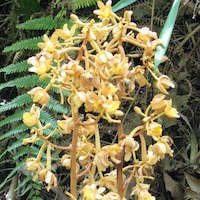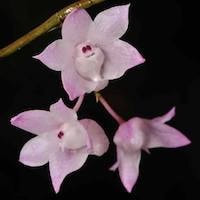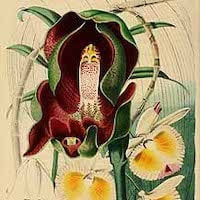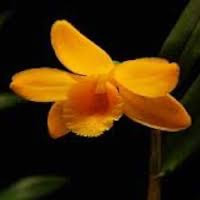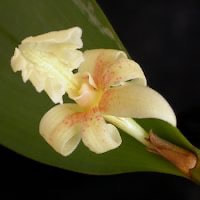WFR9 - Women's Fresh 9 - Fresh Fruit on the rocks
|
Native Singaporean Orchid notes: Brassolaeliocattleya
Brassolaeliocattleya, a stunning orchid hybrid, blends the best traits of a fragrant miniature cattleya and a larger lavender orchid. Created through meticulous breeding, it has become a coveted variety prized for its beauty and fragrance. Its flowers, initially compact yet generously sized, showcase a range of colors from deep pink to soothing lavender. A distinctive feature is its lip adorned with a golden hue, creating an elegant contrast against the vibrant petals. Known for its captivating fragrance and aesthetic appeal, Brassolaeliocattleya stands out as a masterpiece in orchid cultivation, enchanting enthusiasts with each bloom.
|
Therapeutic Orchid notes:
|
Cyrtosia septentrionalis (Rchb. f.) Garay
Cyrtosia septentrionalis, also known as Galeola septentrionalis, thrives in forest understories and has evolved a self-pollinating system due to limited insect pollinators. Its phytochemical profile includes glycosides and phenolic derivatives like gastrodin and 4-hydroxybenzylalcohol. In traditional medicine, it treats muscle stiffness with topically applied paste made from the plant and oil. The fruit, decocted with licorice, treats gonorrhea, echoing its historical use in Japan. Additionally, its ash has been used as a scalp tonic for treating scalp diseases. |
|
Dendrobium aduncum Lindl. Syn D. scorianum W. W. Smith, D. faulhaberianum Schltr.
Dendrobium aduncum, also known as noble hook Dendrobium, yellow herbal Dendrobium, and other names, thrives across the Himalayan foothills, southern China, and parts of Southeast Asia. In traditional herbal medicine, known as Shihu, its stem is prized for nourishing properties that promote vitality and reduce fever. It aids digestion, quenches thirst, and supports weak individuals with poor appetite. This orchid's traditional use underscores its potential as a natural remedy for enhancing vitality and overall well-being. |
|
Dendrobium devonianum Paxton D. pulchellum Lindl.
Dendrobium devonianum, also known as teeth pedal Dendrobium or Chiban Shihu in Chinese, blooms in April or May and is recognized by various names in Thailand like Miang and Ueang sai. It contains antioxidant compounds and a unique flavonol glycoside, 5-hydroxy-3-methoxy-flavone-7-O-[beta-D-apiosyl-(1-6)]-beta-D-glucoside. In traditional medicine, its pulp treats boils and pimples when applied topically in Nepal, showcasing its potential healing properties for skin conditions. |
|
Dendrobium lohohense Tang & F.T.Wang
Dendrobium lohohense, known as Luohe Shihu or Luo River Dendrobium in Chinese, and Chukanso in Japanese herbal medicine, contains shihunine, which shamans in the Amazon Basin use in rituals. Shihunine converts into betaine, a compound found in dietary supplements for managing high homocysteine levels linked to heart disease and stroke risk. In Chinese medicine, it's valued as shihu, used for various health benefits, though consuming it doesn't guarantee cardiovascular disease prevention or treatment. |
|
Dendrobium plicatile Lindl. syn. Flickingeria fimbriata (Blume) A.D. Hawkes; Dendrobium macraei Lindl.,
Dendrobium plicatile, also known as Flickingeria fimbriata or Dendrobium macraei, is an orchid species with various names in different cultures. In India, it is called Jibai, Jibanti, Jivanti, Radarudi, and Wajhanti, while in Sri Lanka, it is known as Jata makuta. In China, it is named Liusu Jin Shihu or Tassels gold Dendrobium, used in traditional medicine as Youguashihu. This orchid has long, branching pseudobulbs and small white flowers that bloom briefly. It contains alkaloids, phenanthrenes, and other compounds with cytotoxic, antioxidant, and medicinal properties. In Ayurvedic medicine, it is considered cooling and mucilaginous, used as a tonic for bile, blood, and phlegm disorders, and as an aphrodisiac. |
Other scent note
Ivy, Tobacco leaf, Lemongrass, Eucalyptus, Sage, Vine, Tobacco, Ginkgo, Violet leaf, Juniper, Wintergreen
Scentopia Library Reference ingredient
Fir - Check details at Scentopia's scent library
Download the guided mediation that works best with this Orchid fragrance oil
| women_fresh_essential_oil_orchi_00009.mp3 | |
| File Size: | 4033 kb |
| File Type: | mp3 |

